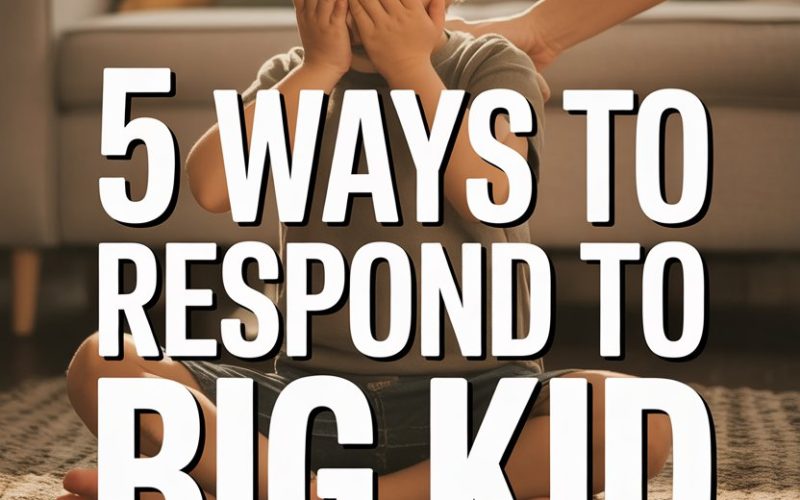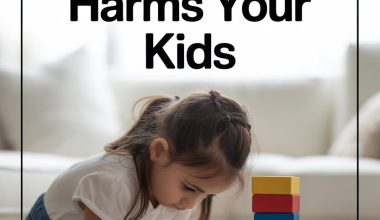No one warns you that kids don’t just grow out of tantrums—they grow INTO bigger ones.
The volume increases, the vocabulary gets spicier, and the “But WHY?”s take on a philosophical edge that would make Socrates sweat.
For busy parents, handling these outbursts can feel like wrangling a wild raccoon into a ballet tutu: not impossible, but highly unlikely to go smoothly on the first go.
Here are five practical ways to respond to those big feelings (without losing your own).
1. Name the Emotion, Even When It’s Obvious
When your seven-year-old is shrieking about the unfairness of broccoli, it’s tempting to respond with your own Oscar-worthy outburst. Instead, try calling out the emotion you see.
“Wow, you’re really angry right now.”
This isn’t just a stall tactic. Naming emotions aloud helps kids develop emotional literacy, which can calm the stress response in the brain.
Researchers from the University of California, Los Angeles found that simply putting feelings into words can reduce emotional intensity (source).
By labeling what’s happening, you’re giving your child a roadmap for what’s going on inside—and showing them it’s okay to have big feelings.
Don’t worry about getting it wrong. If you say, “You seem frustrated,” and your child bellows, “I’M FURIOUS!” then congratulations—you’ve at least distracted them for a second.
2. Respond with Calm, Not Volume
Matching your child’s decibel level tends to escalate things faster than a toddler with a Sharpie and a white wall. Instead, lower your voice and slow your pace.
This isn’t just parenting folklore. According to Dr. Laura Markham of Aha! Parenting, children are wired to “co-regulate” with the adults nearby (source).
When we react with calmness, we lend our nervous system to theirs, helping them come down from their emotional Everest.
Lowering your voice can feel a bit like whispering directions to a charging bull, but it works surprisingly often. If nothing else, you’ll save your vocal cords and maybe even confuse your child into a moment of silence.
3. Create a “Chill Out” Option (Not a Punishment)
Every child deserves a space where they can cool off—preferably without being made to feel like the world’s worst villain. Instead of sending your child to “time out,” invite them to take a break somewhere cozy.
Call it a chill corner, a peace tent, or even just “the sofa with the squishy cushions”—anything but “punishment chair.” Stock it with sensory-friendly items: a soft blanket, a squeezy stress ball, perhaps a book about angry dragons.
The key here: don’t force it. Let them choose when and if to use it.
The idea of a “calm down space” has roots in positive discipline approaches advocated by experts such as Jane Nelsen (read more). This option teaches kids self-regulation, rather than just compliance.
Of course, sometimes the only break you’ll get is when they storm off to slam a bedroom door. Honestly, that counts.
4. Set Boundaries, Then Circle Back Later
Big feelings can make little people (and not-so-little people) lose their grip on kindness. It’s still our job to hold the line.
Try: “I see you’re upset. I won’t let you scream at me, but I’m here when you’re ready to talk.”
Setting boundaries isn’t just about keeping order; it reassures your child that someone’s steering the ship, even in choppy waters.
Dr. Daniel Siegel, co-author of “The Whole-Brain Child,” explains that clear limits combined with empathy build trust and security (learn more).
Circle back later, when everyone’s cooled down. This is your golden window for a heart-to-heart. Don’t deliver a lecture—just reconnect. “That was a pretty rough moment earlier. Want to talk about it?”
Sometimes, your child will leap at the chance to explain why the universe is against them. Other times, a hug and a snack will do.
5. Model Repair (Because No One Gets It Right Every Time)
Every parent has lost their cool and joined the chorus of chaos. If you’ve ever bellowed, “THAT’S ENOUGH!” only to see your child’s eyes go wide with shock, you’re in very good company.
What matters next is how you handle it. Apologize. Model taking responsibility: “I got angry and shouted. That wasn’t fair. I’ll try again.”
This isn’t just about making amends. It teaches children that everyone makes mistakes, and that relationships can be repaired.
According to child psychologist Dr. Becky Kennedy, repairing after a blow-up is one of the most powerful ways to foster resilience (see her take).
Plus, it sets the tone for everyone in the family: big feelings are normal, and what we do after matters.
When the Dust Settles
Big kid outbursts can test even the most patient parent’s Zen. The trick isn’t dodging the storm—it’s learning to ride it out with a little dignity (and, if you’re lucky, a cup of tea that’s still lukewarm).
Next time the volcano erupts, try naming the feeling, offering calm, making space for self-soothing, holding clear boundaries, and fixing things if you blow it. Repeat as needed.
Because the secret isn’t in perfect parenting—it’s in showing up, again and again, with love, patience, and perhaps a sense of humour about the circus you’re running.
And if all else fails, there’s always tomorrow. Or chocolate.





